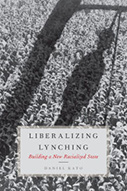Liberalizing Lynching: Building a New Racialized State

Author:Daniel Kato
Publisher: New York: Oxford University Press, 2015. 232p.
Reviewer: Christopher C. Lovett | May 2016
In the 1930s at its New York headquarters, the NAACP flew a flag following every lynching. The flag simply declared in bold print, “A Man Was Lynched Yesterday.” Americans who pride themselves on a time-tested legal framework often have amnesia when it comes to the historical legacy of vigilante justice in the United States. The documentary record shows that very few individuals who orchestrated a lynching were ever prosecuted by either state or federal authorities, from Reconstruction until the dawn of the civil rights era. Now Daniel Kato, an assistant professor of political science at Barnard College, Columbia University, examines the federal government’s role in lynching prevention in his thought-provoking study, Liberalizing Lynching: Building a New Racialized State.
Kato, relying upon political and sociological theory, examines arguments involving the question of whether the federal government’s failure to halt lynching and racial violence in the American South was synonymous with a weak state. But as Kato realizes in this narrative, the problem was more complex. Most Reconstruction historians, such as Eric Foner, believe that Supreme Court rulings, especially in The Slaughter House Cases, had made it impossible for Republican administrations to prosecute the Ku Klux Klan, who waged a virtual race war in the former Confederacy. Although this was true to a point, Kato instead focuses on what he terms constitutional anarchy as a description of the judiciary’s inaction when it came to racial violence. Constitutional anarchy, Kato believes, was a method employed by all three branches of government to avoid an issue that they simply did not want to address. Of course there is no denying Foner’s analysis, but as Kato stresses, this did not make it impossible for the federal government later to enforce those long dormant Reconstruction Acts — particularly starting in 1940, when Franklin Roosevelt’s Justice Department sought to bring law enforcement officials in Indiana to justice for their role in a lynching by enforcing Sections 241 and 242 of Title 18 of the U.S. Code. Kato notes, “Section 241 was taken verbatim from the Enforcement Act of 1870,” the primary tool designed to fight the Klan.
Kato’s insightful approach takes into account the complexities of both domestic and national politics involving racial violence. By relying on legal scholars – Robert Kaczorowski and Pamela Brandwein – Kato tells his readers that what actually transpired is best described as “state neglect.” In all respects, the laws designed to protect freedmen in the South during Reconstruction were simply contained. In layman’s terms, they were consigned to the deep freezer, to be resurrected at a future date, without relying upon new Congressional legislation, as happened in 1966 when the Supreme Court decided United States v. Price and United States v. Guest.
But what accounts for the shift in the judiciary? Kato considers, “[t]he Court’s inconsistency in these matters had less to do with legal maneuverings than with the fluctuating political support for federal rights enforcement.” Even more problematic, the Court in the infamous Plessy decision in 1896, permitted racial segregation in the South “with reference to the established usages, customs, and traditions of the people, and with a view to the promotion of the comfort, and preservation of the public peace and good order.” [Italics added] Although the twin issues of segregation and lynching go hand-in-hand, there is a subtle difference as Kato notes; mainly that there was “no formal ‘lynch law’ that outlined the crimes, trial mechanisms, and means of punishments.” No matter how odious Jim Crow was in terms of violating one’s civil rights, “it was not as anarchic as lynching.” Supreme Court rulings, much like legislative measures, are products of the political environment in which they were made. Through the political leadership of Lyndon Johnson, and the changing political climate in the 1960s, the federal government simply resurrected the Reconstruction measures engrained in the U.S. Code and applied them, nearly a century later, to their original purpose of protecting a beleaguered black population.
Many will misjudge Kato’s splendid study by assuming that the work is just about mob brutality; but Liberalizing Lynching is more nuanced. Kato’s analysis provides an analytical explanation for the inability of the federal government to take action against the racial violence that occurred in the American South. But it is wrong to assume that lynch mobs solely operated in Dixie. Regrettably, lynchings occurred in nearly all of the contiguous states in the Union, and federal authorities were AWOL when it came to halting those barbaric practices. Clearly Kato’s model is applicable to not only the national level, but also to state jurisdictions. Liberalizing Lynchingis a must read for anyone seeking answers to the many forms of violence committed against minorities, when law enforcement either fails to respond or is too slow to bring the perpetrators to justice.
Christopher C. Lovett, Emporia State University


